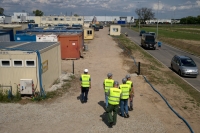With Robust Economy, Poland Navigates Around Eastern Europe’s Strains  Posted on: October 7, 2014 RZGOW, Poland — To the east, Russian aggression has paralyzed Ukraine’s hope for faster economic development. To the south, Hungary flirts with authoritarianism and still struggles to climb out of the last recession. To the north, Lithuania and the other Baltic States are being squeezed by the cycle of escalating trade sanctions between Moscow and the European Union. Poland, meanwhile, has managed to navigate safely around the latest strains on Eastern Europe, just as it managed to sail through the 2008 financial crisis with barely a bruise, maintaining solid growth rates, attracting considerable new investment and industry and using its relative economic strength to build clout within the European Union. By dint of its size, enthusiasm for embracing the West and stable governance, Poland, a member of NATO and the European Union, has long been the most important model of post-Soviet transformation. But now, with Russia again seeking to exert its influence and much of Europe struggling to recover fully from the deep downturn of recent years, Poland has taken on an even more important role as the leading symbol of regional stability and resolve. Construction cranes stretch across the Warsaw skyline. Huge malls and gleaming stores open almost daily. Attracted by wage rates considerably lower than those in Western Europe, many multinational companies continue to invest in Poland as a manufacturing and distribution base. Virtually everything that Ikea, the Swedish housewares behemoth, sells in Europe, for instance, is manufactured in Poland. Many Volkswagen components are made in Poland. General Motors has facilities here, as do 3M, Procter & Gamble and other American brands. Amazon is opening giant new distribution centers. Google Campus Warsaw, mirrored on similar projects in London and Tel Aviv, will nurture homegrown high-tech start-ups. Intent on ensuring that it is not vulnerable to Russian pressure, Poland is pressing the European Union to do more to break its reliance on Russian energy supplies. The recent rounds of sanctions and countersanctions over Russia’s aggression in neighboring Ukraine have had relatively little impact on Poland’s economy, beyond inspiring a patriotic campaign to persuade Poles to eat more homegrown apples in reaction to Moscow’s banning of them. “There has been a small dip in trade with Russia, but double-digit growth in exports,” said Mateusz Szczurek, minister of finance, with a shrug. “They find a way around.” Poland is the only nation in Europe to see growth in every quarter since the financial crisis hit six years ago, with its gross domestic product now 25 percent above 2008 levels while the European Union average remains below that year’s mark. In 2003, Poland exported $53 billion worth of goods. Last year, it was $203 billion. And now some Polish businesses, like Grupa Azoty, Europe’s second-largest fertilizer company, are investing in other nations, something almost unheard-of just a few years ago. There is evidence that the rapid rate of growth might not be sustainable and that the economy has vulnerabilities. Growth in Poland’s G.D.P., which remained robust in the first years of the financial crisis — 4.5 percent in 2011, for instance, according to the World Bank — slowed the last two years, to 1.9 percent in 2012 and 1.6 percent last year. The government’s budget deficit is at worrisome levels and consumer spending, which fueled the Polish economy early in the crisis, has begun to slacken. But even with its limits, the strength of the Polish economy has helped give the country additional credibility and influence in Europe, especially as other countries, like France, Spain and Italy, have stumbled. The most recent evidence for this was the election of Donald Tusk, Poland’s prime minister, as president of the European Council, the first leader from a former Soviet bloc nation to hold such a top-level position. “It is a source of great satisfaction that our voice is better heard and the Polish prominence in European politics is growing,” President Bronislaw Komorowski said in an interview. Poland, with more than 38 million citizens, is by far the most populous of the former Soviet satellite states; four times the size of the Czech Republic, for instance. And it has by far the largest economy in the region. Stanislaw Gomulka, a lecturer for 35 years at the London School of Economics and a longtime adviser to the Polish government, was one of the economists who shaped the “shock therapy” that transformed the Polish economy after the collapse of the Soviet Union and laid the groundwork for the current prosperity. He says those early reforms played a major role in Poland’s economic vitality, as did the auspicious arrival of a gush of European Union aid — so far about 139 billion euros, or $180 billion, with an additional 106 billion euros, or $138 billion, set to land by 2020. “The E.U. money became available in May of 2005, but it took about three years to produce suitable projects on which to spend it, so the investment started to hit the economy just as the financial crisis was happening,” Mr. Gomulka said. “That’s where the luck comes in.” The nation’s low levels of corporate and household debt helped, too. Total household debt, in particular, is below 60 percent of total disposable income in Poland, compared with 93 percent in Germany, 140 percent in Spain and 150 percent in Britain. “The main reason is mortgage debt,” said Witold Orlowski, director of the Warsaw University of Technology Business School. In Poland, the banking sector is quite conservative, he said. Mortgages are not easy to get. And a brief economic downturn in the early 2000s further dampened housing demand just at the moment many other nations were diving headfirst into the subprime morass. “Given a little more time, we might have made the same mistakes as everyone else,” he said. But there are warning signs, economists say. In the prelude to national elections in 2007, the current opposition party proposed a broad package of tax cuts without commensurate trims to spending. Not wanting to hurt its electoral chances, the current governing party endorsed the plan, which economists even at the time recognized would inevitably raise government deficits. Indeed, the deficits grew so large that, in the last two years, the government had to take steps to address them — including steps that some economists attack as accounting gimmickry. All of this has begun to have an impact on domestic consumer spending, Mr. Gomulka said. Economists say that Poland will have to invest more in education and technology and encourage new industries and homegrown brands if it wants to maintain its progress and competitiveness. “The feeling in Poland is that we must move toward a much more innovative economy,” Mr. Orlowski said. Ryszard Petru, president of the Association of Polish Economists, said more difficult medicine may be needed to keep Poland’s economy humming. “We are running out of lower hanging fruit,” he said. “But we have to grow faster than 2 percent a year or we will never catch up with countries in Western Europe.” And to make that happen will likely mean reshaping the Polish economy so it will grow into something more like Germany and other Western powerhouses, instead of being merely a part of the supply chain for those richer nations. There are no globally recognized Polish brands. “Poland has to become the country that makes the final goods, with our own brands,” Mr. Petru said. “That is the challenge of the next 25 years.” But despite these potential storm clouds, many see continuing signs of opportunity. Amazon’s cavernous new facility — 1.1 million square feet of shelves, forklifts and furniture still wrapped in plastic — is rising outside Poznan in western Poland, the first of three such “fulfillment centers” the company is building in the country. “I don’t think we’ve ever gone to another country with such a sizable investment, this much footprint, this much real estate or these many jobs in the first year,” Kerry Person, the new chief of operations for Amazon in Central and Eastern Europe, said as he toured the new facility. It was a sign, he said, of Amazon’s faith in Poland’s economic future. Certainly, there are plentiful signs that free-market capitalism is buzzing in Poland despite the economic travails of the region. One day recently, Lech Walesa, the Gdansk shipyard worker who led his nation to independence and became its first president, sat in a small interview area at one corner of the sprawling Ptak Fashion City, a 660,000-square-foot exhibition center and temple to design that was having its grand opening on the plains south of Lodz, Poland’s textile center. He was one of the event’s star attractions, but was drawing far less attention than the visiting fashion superstars Kenzo Takada, Anna Fendi and Patricia Gucci. Down an aisle lined with cubicles of plaid overalls, leather capes and T-shirts reading “R.I.P. Diet” and “Weird on Top,” just beyond a flock of models in pink miniskirts, a cluster of jeweled fashionistas was studying a rack of necklaces made from bullets. “Better Wear Than Use,” the company slogan went. “If someone told me, when we were fighting against the Communists, that we would have such a place in Poland in 20 years, I would not have believed it,” said Mr. Walesa as he gazed upon the raging capitalism all around him. “This is what I fought for.” Joanna Berendt contributed reporting from Poznan, Poland. Source: Rick Lyman |
Saturday, April 20, 2024, Name day: Agnieszki, Czesława

NewYorkPolonia >> Article



